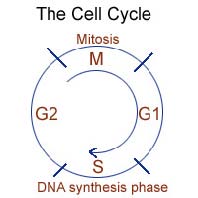Cell Cycle

Cell division is the process by which cells reproduce (mitosis). The cell cycle is a series of changes the cell goes through from the time it is first formed until it divides into two daughter cells. It starts at mitosis (M-phase) and ends with mitosis. In between are the G-1, S, and G-2 phases. The duration of S, M and G-2 are relatively constant in different tissues.
Between the M-phase and the S-phase is a gap (G-l) where production of RNA, proteins, and enzymes needed for DNA synthesis occurs. The duration of G-1 varies and determines the length of the cell cycle.
The S-phase is when DNA synthesis occurs.
Between the S-phase and M-phase is a second gap (G-2). Cells are thought to prepare for mitosis in G-2 when specialized proteins and RNA are produced. G-0 is a dormant phase.
The four phases of mitosis are
- Prophase
- Centrosomes separate and migrate to opposite poles.
- Centrioles separate.
- Chromatin is transformed into chromosomes composed of pairs of filaments called chromatids (each is a complete genetic copy of its chromosome).
- The nuclear membrane disappears.
- Metaphase
- Paired chromosomes become lined up between the centrioles.
- Anaphase
- Chromatids are pulled toward the centrioles. One chromatid from each pair goes to each daughter cell.
- Telophase (divided into parts I and II)
- Telophase I
- Chromosomes become more polarized and transformed into thread-like structures.
- A nuclear membrane forms around each set of chromosomes forming a new nucleus with a nucleolus.
- The centrioles duplicate.
- Telophase II
- Actual dividing of the cell occurs (cytokinesis).
- Cytoplasm splits and two daughter cells are formed.
- Telophase I
Suggested Citation
SEER Training Modules: Cell Cycle. U.S. National Institutes of Health, National Cancer Institute. Cited 20 December 2025. Available from: https://training.seer.cancer.gov.




